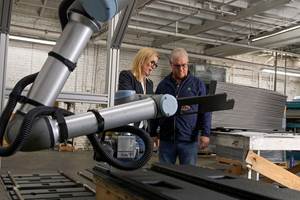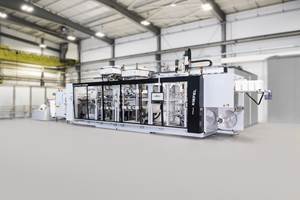EconCore Expands its Honeycomb Cores to Higher-Performance Engineering Resins
SABIC’s Noryl GTX PPE blend featured in latest EconCore cores with potential use for EV batteries and photovoltaic structures.
We have steadily reported on EconCore of Belgium and its proprietary ThermHex thermoplastic honeycomb technology since 2018. At that time, the company had confirmed that packaging was still the cornerstone of its licensing business, with the largest share of licensing dedicated to applications in this sector. So, the range of polymers used primarily included PP, PE, PS, PET, nylon, PC, and ABS, with some projects using PPS and PEI.
Even then, the versatility of being able to connect the steps of first making the honeycomb core with in-line bonding of metal skins to make lightweight and stiff sandwich panels was making this technology appear in an increasing range of transportation applications. For truck trailers and truck bodies, for example, the potential for weight reduction is compelling with honeycomb core material being up to 90% lighter than incumbent solid cores. As a result, leaders in commercial transportation in North America and Europe were adopting the ThermHex technology. Moreover, in combination with different skin materials EconCore honeycombs offer a wide range of application possibilities. Low production costs of EconCore honeycombs enable substitution of other honeycomb cores and homogeneous panel materials. In development projects with its customers and nearly a dozen licensees, the company has developed panels and parts for packaging, graphical, automotive, transportation, building & construction as well as furniture markets. And, as indicated by recent developments, new and more complex applications are being targeted.

In more recent developments, the company is aiming its technology for use with higher-performance engineering resins. An excellent example, is the development of new honeycomb cores for laminated sandwich panels made with SABIC’s Noryl GTX resin, a PPE) blend, and EconCore’s proprietary technology. The new honeycomb core exhibits higher heat performance, better dimensional stability and lower water absorption compared to honeycomb structures made with traditional thermoplastics. These properties enable the new core material to be used in demanding applications such as certain automotive, e-mobility and photovoltaic components. And as previously noted, combining this new honeycomb core with thermoplastic composite skins to produce an all-thermoplastic sandwich panel can facilitate recycling. These desirable performance attributes and enhanced sustainability can open new market and application opportunities for EconCore honeycombs made with Noryl GTX resin.
Said EconCore COO Tomasz Czarnecki, “We turned to SABIC for expert assistance in honeycomb cores with high-performance thermoplastics to expand our product’s use in a range of applications and overcome the limitations of incumbent materials. Our many years of collaboration with SABIC and the company’s broad materials portfolio gave us high confidence in the success of this initiative. We have been very impressed with Noryl GTX resin’s ease of use in conversion and appreciated the fact that it works well in our existing equipment. We believe its well-balanced properties will allow honeycomb cores to be used more widely in transportation, clean energy and e-mobility applications.”
Said Luc Govaerts, director, formulation & application development, SABIC’s Specialties business “Our unique portfolio and deep product and application expertise, combined with EconCore’s proprietary technology, open up new metal-replacement and weight-out opportunities in a wide range of important segments, such as e-mobility and photovoltaics. We look forward to continuing our work with EconCore to create new customer solutions using our specialty materials.”
As we have reported previously, thermoplastic honeycomb structures deliver a high performance-to-weight ratio and efficient energy absorption under impact. The rigidity of honeycomb sandwich panels is known to exceed that of monolithic materials, including solid composites. Also, sandwich structures are an effective means of reducing mass in a wide range of weight-sensitive applications. Combined with an effective, in-line integrated sandwich panel production technology, this weight reduction has positive implications for overall production cost savings and environmental responsibility.

In addition to reducing raw material use, the honeycombs support recyclability. Combining the PPE-based core structures with thermoplastic composites skins, such as those based on nylon, can result in a recyclable and sustainable solution.
Furthermore, sandwich panels made exclusively with thermoplastics can be efficiently processed into finished parts with complex geometries using compression molding processes, which can help reduce cycle times.
According to EconCore, due to the high performance of the PPE blend, the cores may also demonstrate good compatibility with thermoset composite skins. Because the honeycomb exhibits high load-bearing capacity even at temperatures up to 180 C/356 F, it may be a good candidate for lamination with thermoset prepregs in processing environments where high curing temperatures are typically applied. The honeycomb can also potentially be used for applications where sandwich panels must deliver high performance at elevated temperatures.
EconCore honeycombs are produced from a single continuous thermoplastic sheet using the company’s patented technology. In this unique process, the material is extruded and in-line formed into the honeycomb structure without the need for secondary operations. Specifically, this involves a sequence of extrusion and thermoforming steps to transform the extruded film into a half-hexagonal web that is directly folded into a thermoplastic honeycomb structure.
The high efficiency of this continuous process minimizes production costs, making the product very competitive economically. Furthermore, the technology allows for integration of the skin lamination step in-line with the honeycomb core production, providing opportunities for effective, continuous manufacturing of value-added laminated sandwich panels.
EconCore’s technology also offers expanded freedom to design and produce a wide range of honeycomb cell sizes, core thicknesses and densities.
Related Content
Thermoformer Maximizes Productivity with 3D Printing
Productive Plastics has created an extensive collection of 3D printed manufacturing aids that sharply reduce lead times.
Read MoreCobot Creates 'Cell Manufacturing Dream' for Thermoformer
Kal Plastics deploys Universal Robot trimming cobot for a fraction of the cost and lead time of a CNC machine, cuts trimming time nearly in half and reduces late shipments to under 1% — all while improving employee safety and growth opportunities.
Read MoreUpgraded Former is Faster, More Precise
New features reportedly offer more efficient production of trays, containers, hinged boxes, pallets, blisters, lids and technical products.
Read MoreOMV Technologies Gets New CEO
Kooper brings 33 years of experience in the industrial and consumer packaging industries to OMV--the closed-loop, turnkey, inline extrusion, thermoforming and tooling systems manufacturer.
Read MoreRead Next
People 4.0 – How to Get Buy-In from Your Staff for Industry 4.0 Systems
Implementing a production monitoring system as the foundation of a ‘smart factory’ is about integrating people with new technology as much as it is about integrating machines and computers. Here are tips from a company that has gone through the process.
Read MoreProcessor Turns to AI to Help Keep Machines Humming
At captive processor McConkey, a new generation of artificial intelligence models, highlighted by ChatGPT, is helping it wade through the shortage of skilled labor and keep its production lines churning out good parts.
Read MoreAdvanced Recycling: Beyond Pyrolysis
Consumer-product brand owners increasingly see advanced chemical recycling as a necessary complement to mechanical recycling if they are to meet ambitious goals for a circular economy in the next decade. Dozens of technology providers are developing new technologies to overcome the limitations of existing pyrolysis methods and to commercialize various alternative approaches to chemical recycling of plastics.
Read More








.png;maxWidth=300;quality=90)

















